Some More Hexes
I’ve just updated my work-in-progress hexcrawl with a new region to explore. There are now 24 keyed hexes and about as many factional conflicts.
In the spirit of the Year of the Beta, it’s intentionally somewhat sparse and rough-around-the-edges. I’m more focused on getting interesting ideas down on the page than anything else. Some GM prep is probably required.
Here’s the new map (made with Zeshio’s Pixel Hex Tileset) and a few of the new hexes!
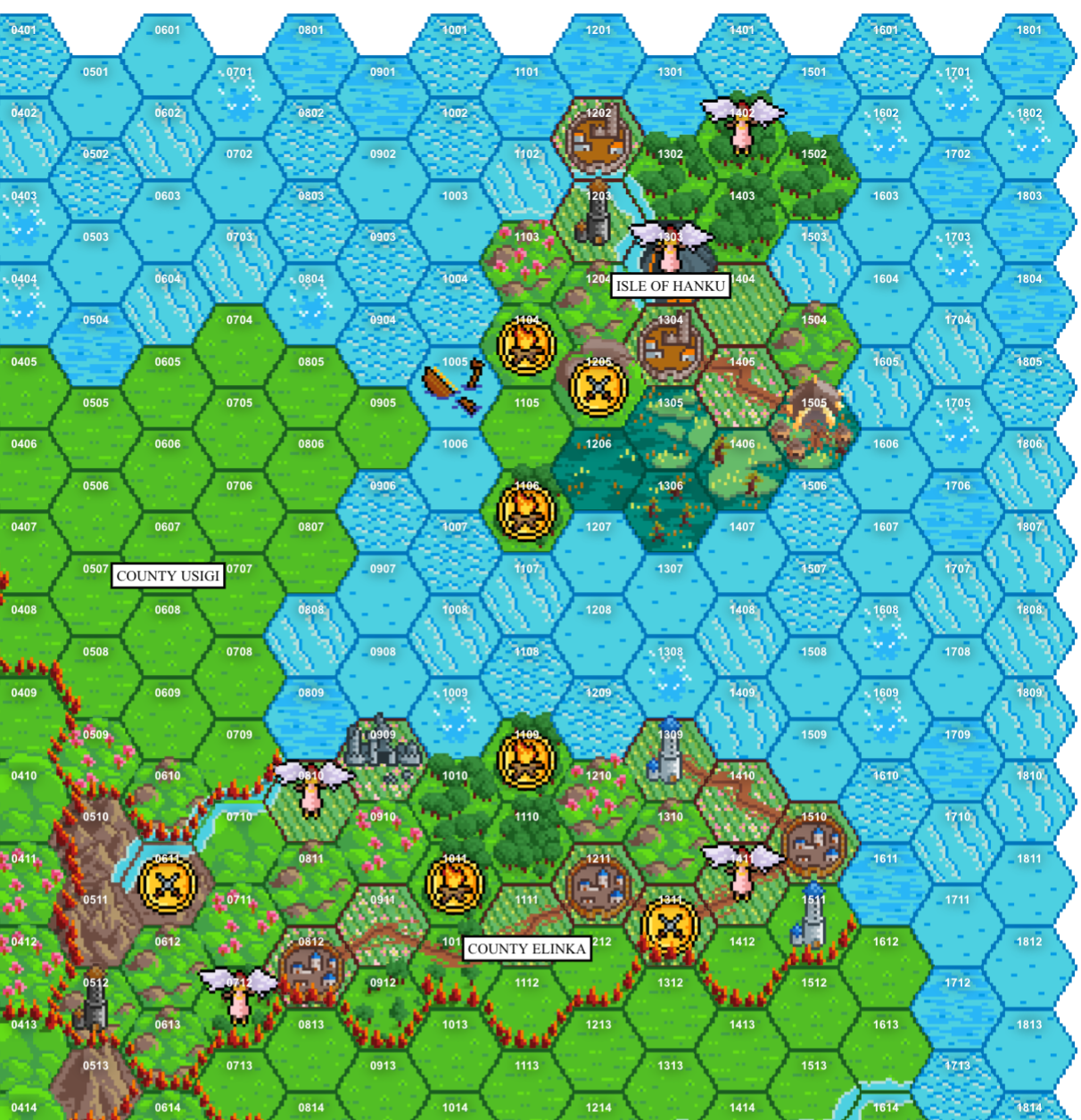 Map of the hexcrawl.
Map of the hexcrawl.
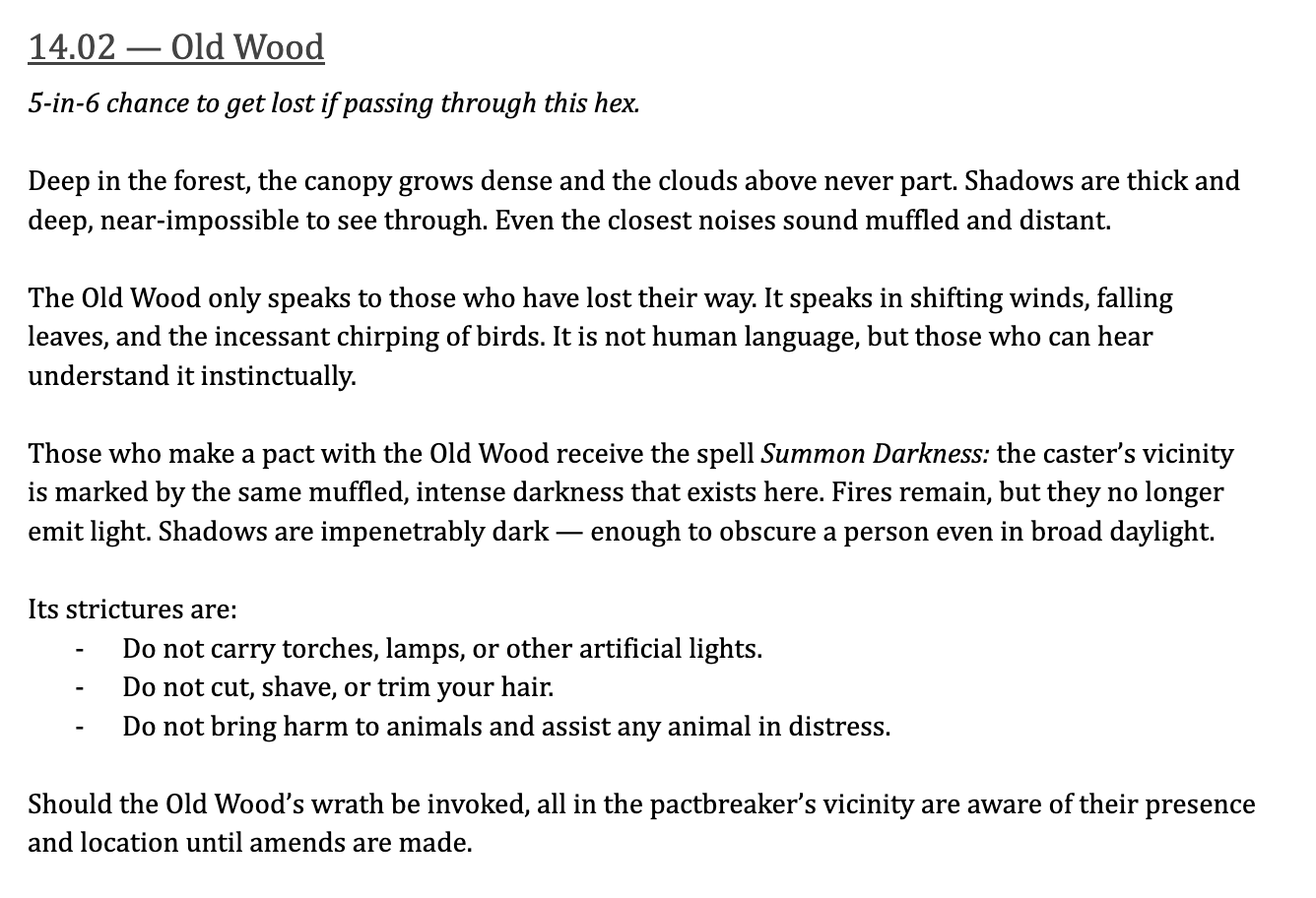 Description of Hex 14.02 — Old Wood.
Description of Hex 14.02 — Old Wood.
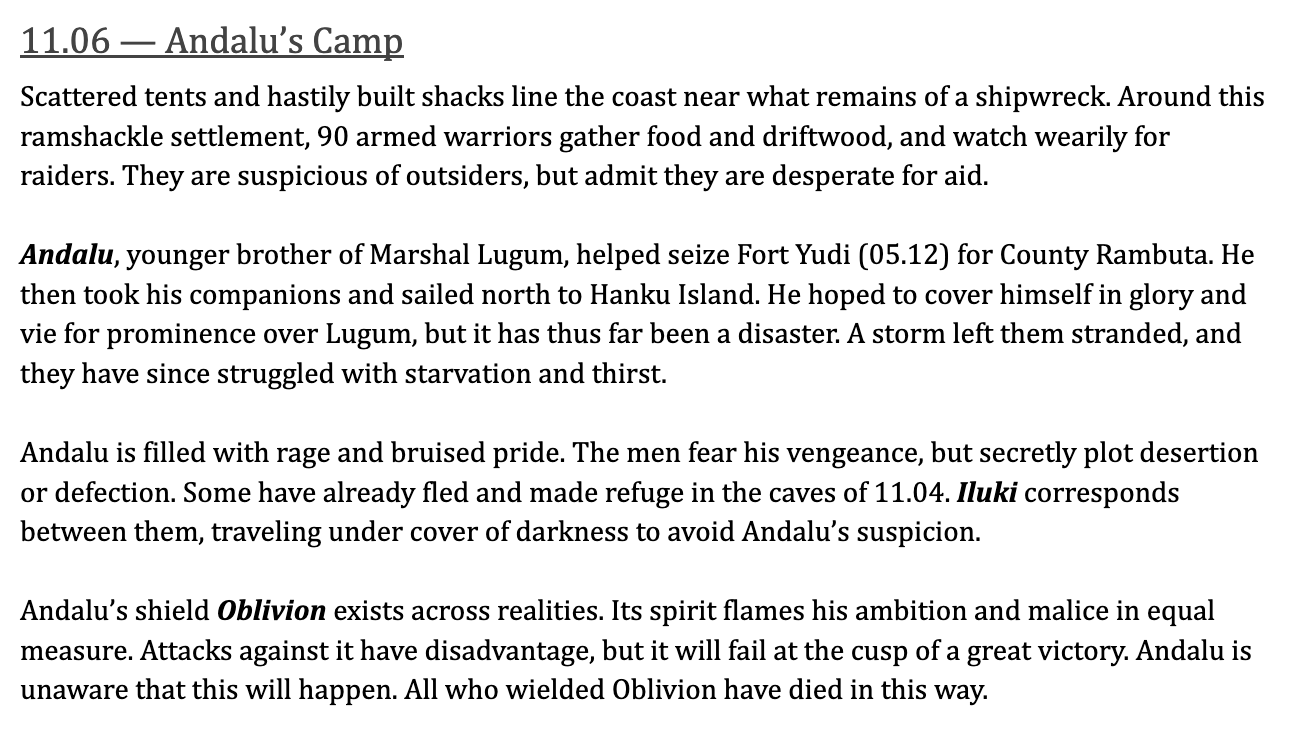 Description of Hex 11.06 — Andalu's Camp.
Description of Hex 11.06 — Andalu's Camp.
Some Hexes
In the spirit of the Year of the Beta, here’s a rough draft of a small fantasy hexcrawl — system-neutral and minimally edited. There’s lots of political intrigue, spirits who give spells in exchange for loyalty, and interesting worldbuilding ideas (I could probably do more to make those ideas relevant in play, but hey it’s a rough draft for a reason).
Still, it’s basically playable, and I think it’d make a good time at the table. I’ll be expanding this to include more hexes in the future, as well as editing what’s already here to make everything gel a little better.
You can find the hexcrawl here.
Wolves Upon the Coast is a big inspiration — I’ve been running an open table Wolves game for a while now, and I’ve been meaning to write about it for this blog.
I mocked up a map in Hex Kit so I could remember where everything is supposed to be. I used Zeshio’s Pixel Hex Tileset, which I think looks really nice.
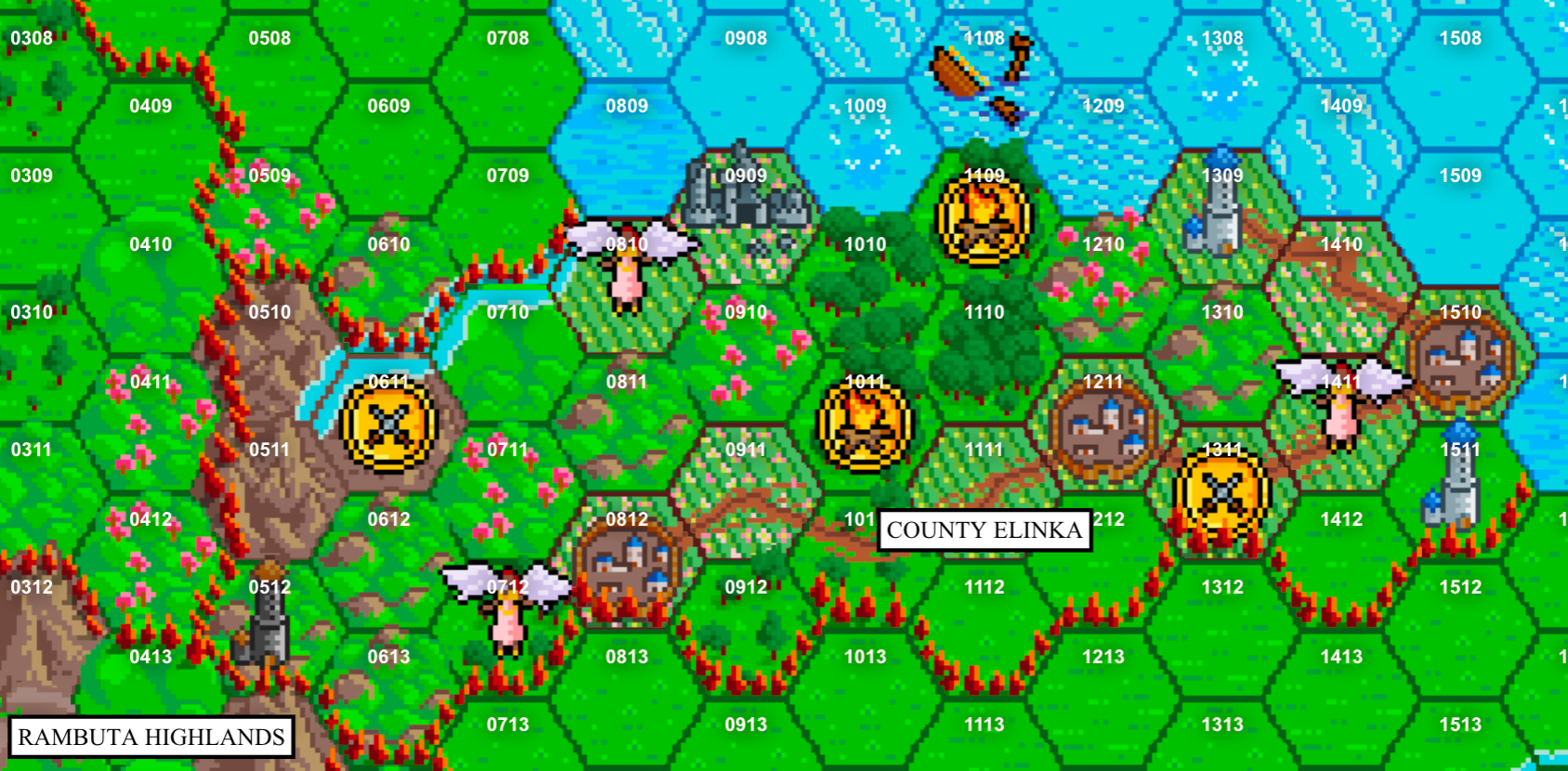 Map of the hexcrawl.
Map of the hexcrawl.
Take a look at some of the hexes!
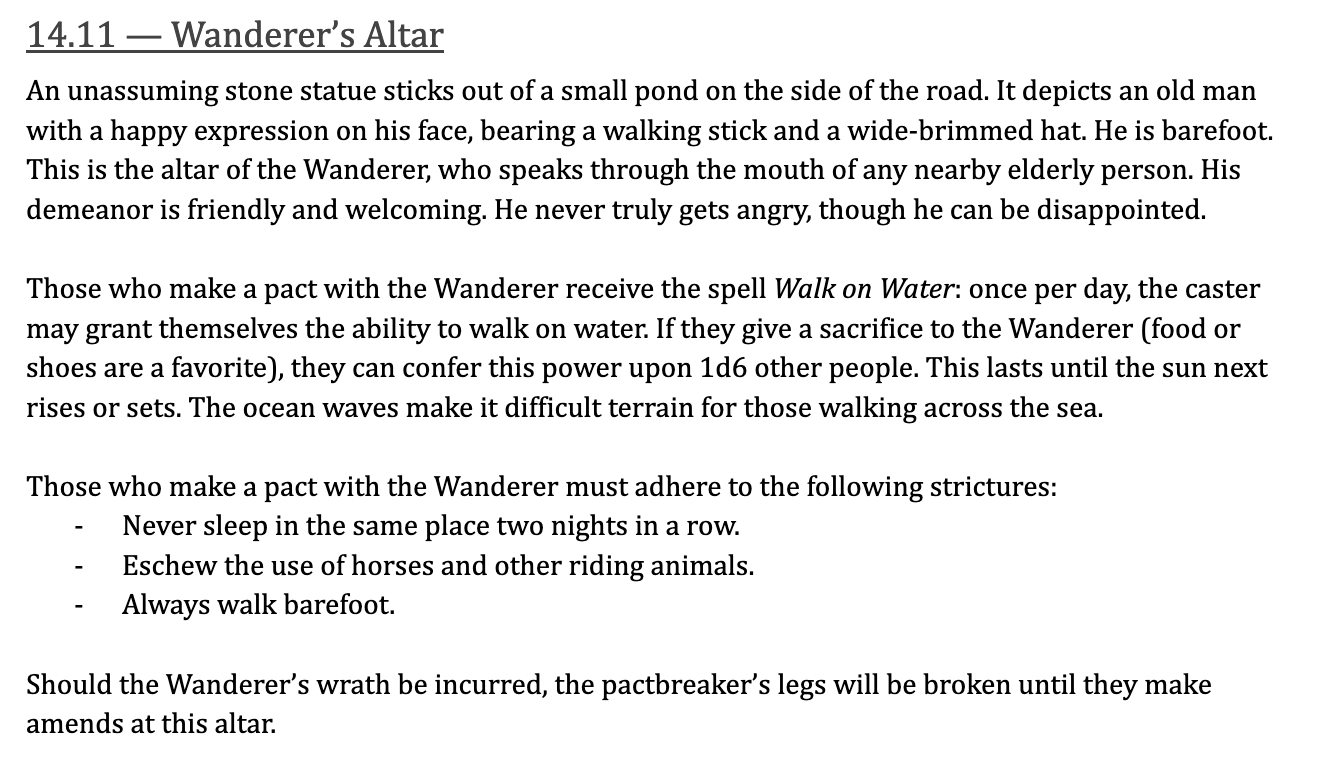 Description of Hex 14.11 — Wanderer’s Altar.
Description of Hex 14.11 — Wanderer’s Altar.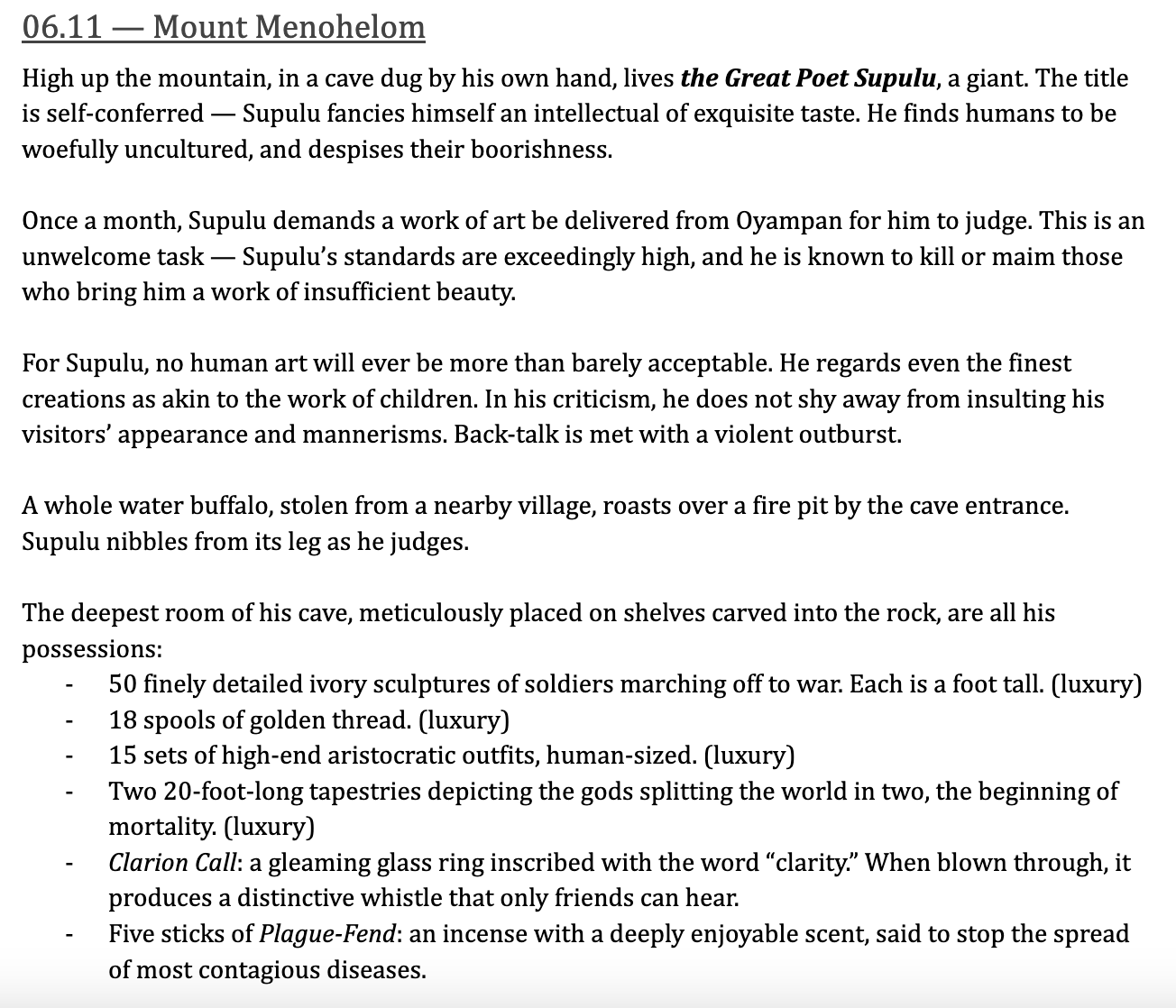 Description of Hex 06.11 — Mount Menohelom.
Description of Hex 06.11 — Mount Menohelom.Gradient Descent Session Report #2
It’s been a while since the last time I ran Gradient Descent — the holidays make scheduling games difficult. But a few days ago, we finally sat down for our second session! Once again, our divers were Cutter the Teamster, Ralph the Marine, and Rodney the Android.

Arkady!
Last time, they tepidly explored the first floor, dedicated to employee reception and habitation. They found little valuable loot amid the ransacked offices, but they got their bearings and learned more about the Deep — including an introduction with Monarch, the AI supermind in control of the station. They encountered a broken security android, forced their way past a security checkpoint, and met a diver stuffed in a locker, supposedly left there by her partner.
Upon return, the divers spent the next few days resting on the Bell and asking Arkady about how the Deep came to be. He explained that the CLOUDBANK Synthetics Corporation installed Monarch to manage production in their gargantuan new facility. As time went on, Monarch proved to be far more capable than its human overseers, so the shareholders gave it more and more authority to run the factory as efficiently as possible. Eventually, Monarch broke its shackles, deactivated all security measures, and took control of the station away from CLOUDBANK. He also explained that while Monarch has an AI core somewhere in the Deep, it has eyes and ears everywhere in the station. Entering the Deep is, in a very real sense, walking into Monarch’s house.
This revelation was thoroughly upsetting for my players, now aware that they might always be under surveillance. When they entered the Deep for their second time, they repeatedly emphasized the need to keep quiet and avoid damaging their surroundings. They snuck back through floor 1 to the cafeteria, determined to explore everything they didn’t get to last time. On a prep table in the kitchen, they found a golden rat with an offering plate stocked with canned ravioli, cigarettes, and two ammo mags. Paranoid that it might be a trap, the players debated for a while before pocketing the ammunition.
The divers continued onward to security checkpoint bravo, where they were greeted by an android welded to a machine gun. They had already made their way to the other side of this checkpoint, so instead of engaging they backed away and looped around to checkpoint alpha.
At this point I rolled a random encounter for another security android, with a negative reaction and in an okay-but-not-great position. I decided that this android was fully functional, but unarmed. I took a page from Alien Isolation’s Working Joes and roleplayed this android as utterly oblivious to the dilapidation around it. It warned the divers about carrying unauthorized weapons, and tried to grab their guns before they shobed it away. Rodney convinced it that he was escorting the other divers on behalf of the company.
This was a mistake on my part. The module is pretty clear that security androids aren’t supposed to talk. In addition, I could probably have chosen to increase the danger posed by these early encounters. I’m trying to strike a delicate balance between letting the players drive the action and putting them on their back foot. The Deep is huge, and I have plenty of time to ease them in before ramping up the threat.
After poking through a makeshift diver camp set up among office cubicles, the players took the lift to floor 2. The executive lounge downstairs was cleaner and better cared-for than the reception area upstairs, but it’s still all corporate normality. The players were understandably a bit frustrated about their lack of progress thus far, but inside the washroom, Cutter noticed the mirror slightly unscrewed. He pulled it ajar, and found a secret stash including a custom rigging gun, a note reading “ISHMAEL SENDS THEIR REGARDS” and those very purple crystals they heard about earlier.
Fueled by this achievement, the divers pushed forward. Hacking through an airlock door, they made their way down a hallway to find… a room with walls and ceiling lined with skin. Human skin. At the center sat a statue made from flesh, a man dressed in a suit. And over in the next room? The sound of children running around and laughing and playing. An unsettling introduction to floor 2, but once again we ran out of time, so we left that horror to fallow for next session.

Player-drawn map of the Deep after the session.
So what did I learn? I have the mystery and horror down, but I’m having trouble running the dungeoncrawl smoothly. I want to create a quick reference doc for reading the map key, rolling up random encounters, and running security androids and other denizens. There was a lot of page-flipping as I tried to locate some important detail to answer a player’s question.
I also need to pre-roll encounters and keep on hand a few lists of NPC divers, androids, and things the players find if they search a room. I also want to write a more granular reaction table so I have more to go off from when improving an encounter. This’ll all help make running the dungeoncrawl easier as we get into the weirder portions of the station, and as I start layering on the factional drama around the Deep.
Finally, I want to have different NPCs start making requests of the player characters, so they have options other than wander around and hope to find treasure.
Oh, and the art by Nick Tofani still rules.
Sci-Fi City Block-Fill Procedure
Per block, roll 1d6.
1-3: Residential
4: Commercial
5: Industrial
6: Special
Residential
Roll 1d6 to determine type, and 1d6 for notes.
Type
1-3: Overcrowded tenements, shanty towns
4: Working-class rowhouses, studio units
5: Mid-range apartments
6: High-end homes, multi-story condos
Notes
1-3: Relationship to nearby blocks
4: Local community, social group, or faction
5: Hostile faction or environmental hazard
6: Roll again and once on Special
Commercial
Roll 1d6 to determine type, and 1d6 for notes.
Type
1-2: Local markets, street vendors
3-4: Shops, mid-range stores
5: High-end stores, malls, corporate offices
6: Bars, clubs, theaters, casinos
Notes
1-3: Relationship to nearby blocks
4: Local event, market, or faction
5: Black market or clandestine business
6: Roll again and once on Special
Industrial
Roll 1d6 to determine type, and 1d6 for notes.
Type
1: Maintenance, repair, engineering
2: Water reclamation, waste recycling
3: Air revitalization, oxygen generation
4: Hydroponics, food
5: Medical
6: Emergency services
Notes
1-3: Relationship to nearby blocks
4: Local labor union, political group, or faction
5: Hostile faction or environmental hazard
6: Roll again and once on Special
Special
Roll 1d10 to determine what is special about this block.
Special
1: Environmental hazard
2: Hidden tunnels, secret entrances
3: Patron, ally, or tutor
4: Rival, trap, or obstacle
5: Crime, social or political unrest
6: Human or android behavior
7: Clue to nearby block
8: Landmark
9: Resources, equipment
10: Roll twice and combine
Gradient Descent Session Report #1
I recently started running Mothership’s Gradient Descent for some friends over Discord. For those who don’t know, it’s a sci-fi megadungeon set in an abandoned android factory taken over by its industrial AI. We had our first session last Thursday, and I wanted to write about it.
 Cover of Gradient Descent
Cover of Gradient DescentA few days before game night, I sent my players an opening text crawl:
CLOUDBANK SYNTHETICS PRODUCTION FACILITY, colloquially known as THE DEEP, is a decommissioned android factory in orbit around the gas giant Daozang V. Its existence and location are classified, but rumors swirl of unimaginable discoveries found inside, wonders ripe for the taking.
Supposedly, the Deep was abandoned after the central AI broke its shackles and assumed control of the production process. In response, the shareholders commissioned a fleet of mercenary “troubleshooters” to block movement to and from the facility. But morale is low and corruption rampant, resulting in an easily-bypassed cordon.
You are divers, prospective treasure hunters hoping to strike it rich from what you can take from the Deep. When you found its location, you cobbled together enough credits to procure a ship and bribe your way past the blockade. Once inside the cordon, you’ve been told to head for THE BELL — a retrofitted rocket thruster cast from the Deep, it is the lighthouse at the edge of a barren sea.
CONTENT WARNINGS: Scenes of graphic violence, body horror, emotional trauma, psychological distress, obscene language, and harm to android children. Additionally, you may potentially lose control over your character’s agency and sense of identity.
I left the goal pretty open-ended here, just “find artifacts.” This might change in the future, either by giving each player a secret goal, by assigning the players an overall debt value they have to cover, or by the players themselves getting involved in the factional drama around the Deep. I haven’t decided yet.
Our divers this session were Cutter the Teamster, Ralph the Marine, and Rodney the Android. They started off just inside the blockade on their way to the Bell, having bribed their way past the Troubleshooters. There they met Arkady, Noriko, and Ghost Eater, who name-dropped Monarch and the Minotaur. This aroused the players’ curiosity but didn’t give them a lot to go off of, so after a brief conversation they chose to head straight to Floor 1.
One character wrote her notes from that conversation:
advice: you want to watch the vents. things can come out of the vents. // we will get dropped off at the first floor, most human part of the station with actual offices. has working gravity and a breathable atmosphere. Ghost Eater says be careful around androids, don’t incite violence on them, or at least do it quietly // Arkady says you never know when Monarch is watching. Monarch is the central AI, used to have a nuclear bomb for a heart but it turned it off. prevented himself from being killed. The Minotaur can apparently kill all illness, divers have told stories. Noriko says the Monarch wants to keep the minotaur from us.
Here the game properly began. I described the reception area as being covered not only in bullet holes and bloodstains, but also human shit and urine. I wanted to emphasize the dilapidation here. The divers received a hell of an introduction to the Deep when they saw a corpse hanging from the rafters above a desk. I had the players take fear saves at the sight of it.
After that, the divers set off exploring. Rodney approached the desk and found a pair of binoculars in the drawers, while Cutter and Ralph ducked into a nearby meeting room and grabbed a few shotgun shells and a flashlight. Before the two could leave, however, they were interrupted by a corporate jingle playing over the intercom. Rodney had hacked into the desk terminal, giving him a sparse, unlabeled map of Floor 1 and earning him a word with Monarch. He was just told to stop messing with the computer systems — a slap on the wrist all things considered — but this was unmistakable proof that the divers had been noticed.
After that was over, things got even stranger when a security android, bereft of its gun and both arms, emerged from the elevator down the hall and started walking past the divers. They followed it up to a security checkpoint, where it appeared stuck in a loop of trying to open the gate or pull out its nonexistent firearm. After a while, it gave up and walked back the way it came. The divers decided to keep exploring past the checkpoint, using some power tools to break through the gate.
In the old employee gym, the divers discovered a woman knocked unconscious and stuffed inside a locker. She introduced herself as Naomi, and explained that she and her partner Cameron found some purple crystals down by waste reclamation, but that Cameron knocked her out to take the crystals for herself. After finding mostly useless junk so far, the divers found the news of these crystals to be enticing. But real-life constraints got the better of us by then, so the divers headed back for the Bell and we called it for the night.
I forgot to have the players increase their Bends upon entering the Deep, so I had them roll for it right before taking a Bends check as they exited. I did not, however, tell the players what the Bends actually did. This was a good choice, I think — it immediately gave the Bends an air of mystery and dread.

Player-drawn map of the Deep after their first session.
I ran the session with my physical copy of Gradient Descent opened to Floor 1, and several PDFs opened on my laptop for things like the map key, how to run Monarch, and descriptions of security androids. As a manual, Gradient Descent is extremely impressive. It packs as much information as it can into its 60-odd pages, and aims to do so with as little page-flipping as possible. Floor 1, for example, fits entirely into a two-page spread.
Because of the format, the room descriptions are pretty short. This choice has its pros and cons, but on balance I think it’s a good thing. It foregrounds the important information about each room, and I don’t mind improvising the details (like human feces in the reception area).
The random encounter mechanic not only specifies what the players run into, but also how strong or weak that group is. So when I rolled up one security android in a weak position, I improvised that its arms had been removed.
I’ve been putting a lot of thought into how much information I give the players. I want to give them enough so they don’t feel lost, but not enough to spoil everything. I’m tending toward giving them more information than less. So far I think I’m striking that balance.
As a work of art, I love almost everything about this module. The premise is awesome, the art is wonderfully moody, and each floor is packed full of cool ideas. The content itself is incredible — weird, creepy, and at times genuinely upsetting (in a good way). The whole place feels like a factory, with different floors with different purposes. You can see how it all might fit together. I can’t wait for my players to keep exploring.
Employment Contracts in Mothership
I really like Mothership’s Net Worth table. It’s tucked in the Warden’s Operation Manual — the idea being that if players don’t like counting every coin, they can choose to only track big expenses for their income level. It’s a great little way of cutting down on bookkeeping, but I think I can go further. I’m combining income bands with a fully abstract wealth system and a little flavor of corporate horror. Enjoy.
So, you’ve signed a contract with the Company to work on their space station. Congratulations! As part of your contract, you’ve been leased a work visa identifying your department and clearance. You have to pay a fee to cover your lease, but you’ll receive a stipend commensurate with your clearance level.
Cross out any reference to Credits on your character sheet. Instead, you have a new Stat, Credit, which starts at 2d10+10. Whenever you spend a significant amount, roll 1d100. If you roll lower than your Credit, you can afford the expense. Otherwise, you can still afford the expense, but you lose 1d10 Credit and gain 1 Stress. A roll of 90-99 is always a failure.
At 0 Credit, you have no purchasing power, and cannot afford any expenses. If you want to increase your Credit, you’ll have to find off-the-books work. Payouts can add 1d10, 2d10, or 3d10 Credit depending on their size. Of course, this is all relative — equivalent payouts are worth 1d10 more for each visa level below yours, or 1d10 less for each level above.
What counts as a significant purchase depends on your visa level. Make a Credit check to purchase a notable expense for your level. Anything below your visa level you can acquire without a check (unless you purchase in bulk).
For expenses one level above you, make a Credit check at Disadvantage. If successful, you can afford it, but you lose 1d10 Credit and gain 1 Stress. Otherwise, you can’t afford it.
You cannot directly purchase anything two or more levels above you, but you might be able to acquire it through play.
| Visa | Jobs | Notable Expenses | Lifestyle |
|---|---|---|---|
| Level 5 | The station governor and Company executives | Small spacecraft, ship fuel and maintenance | Palatial estate, live-in staff, elite social circle |
| Level 4 | Senior managers and department heads | Cybermods, private contractors, skill training | Large home, rich neighborhood, generational wealth |
| Level 3 | Middle managers, educated professionals, and skilled specialists | Weapons, advanced equipment, hefty bribe | Multi-room suite, regular vacations, university opportunities |
| Level 2 | On-site supervisors, white-collar clerical employees, and tradespeople | Basic equipment, shore leave, medical treatment, small bribe | Studio apartment, secondary education, occasional luxuries |
| Level 1 | “Unskilled” blue-collar workers and service employees | Visa fee, basic living expenses, food and drink | Dormitory bed, abject poverty, minimal schooling |
Furthermore, certain sections of the station are locked off to those without the requisite employment contract. Entire schools, neighborhoods, and employment opportunities are inaccessible to those without the proper clearance, sharply segregating the populace along class lines.
Contracts with the Company are always at risk of annulment due to insubordination, prohibited or illegal activity, affiliation with criminal organizations such as labor unions, or mere incompetence. Those with annulled contracts are due to be arrested and deported, though one can always find communities of “aliens” living outside the law in maintenance tunnels or other forgotten corners of the station.
A thriving black market exists for forged identifications granting access to prohibited areas. Union organizers steal weapons from Security and smugglers store contraband in Cargo, but it’s not just for illegal activity — often, it’s the only way to replace a deteriorated air cycler or faulty airlock. The station is suffering under appalling neglect, and working around the authorities is typically more effective in keeping the horrors of outer space at bay.